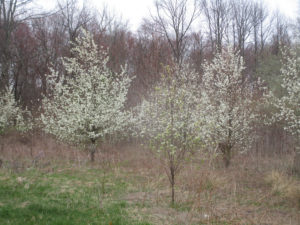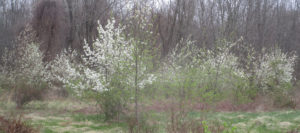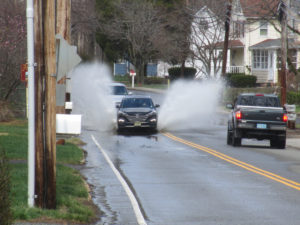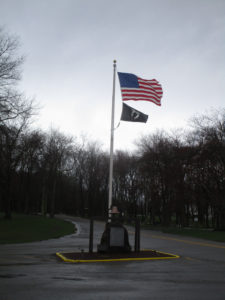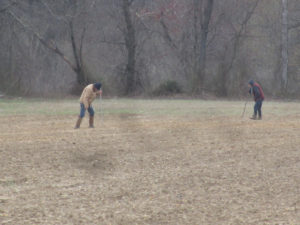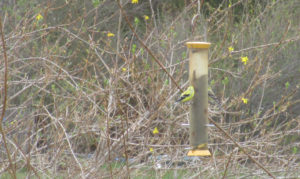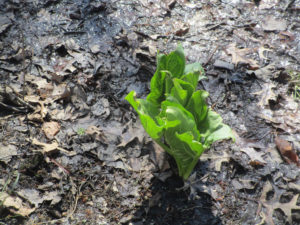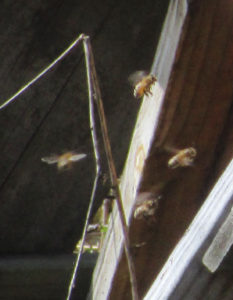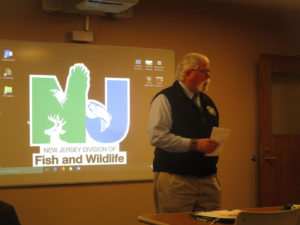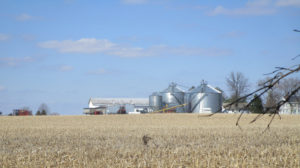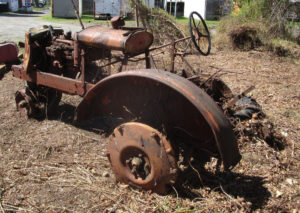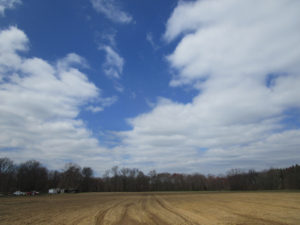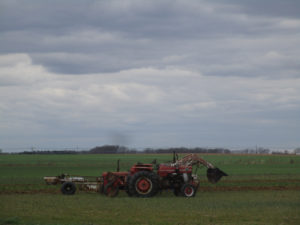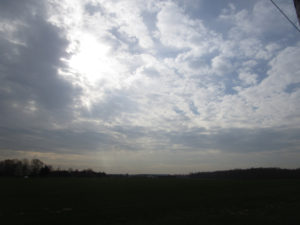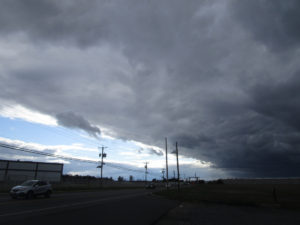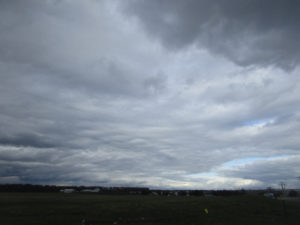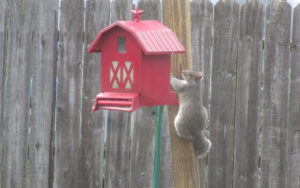Notes From Garden & Afield — Week of April 15, 2018
Article and photos by Joe Sapia
Callery pear trees taking over a field in Monroe, Middlesex County.
CALLERY PEAR TREES: Have you noticed the trees of blooming white flowers in abundance during your travels? Pretty? As we drive by them, yes. But take a closer look, these non-native, but once popular ornamentals, have large thorns, have week branches, and grow thickly. This thick growth prohibits beneficial native plant life from growing. Calleries cross-pollinate easily and produce small pears, which birds eat and, then, poop seeds through the countryside — resulting in more calleries. Enjoy the view and learn from them — that is probably the only good I can say about them.
Callery pear trees along Route 130 in East Windsor, Mercer County.
A closeup of callery pears in Monroe, Middlesex County.
HEAVY RAIN…: The Jersey Midlands got clobbered with rain on the Sunday-Monday overnight and Monday, April 15-16 and 16. The National Weather Service reports the following rainfall totals in Midlands counties, although these reported records may not be complete records:
Burlington: 1.94 inches at Joint Base McGuire Dix Lakehurst to 2.50 at Southampton.
Hunterdon: 2.34 at Lebanon to 2.51 at Readington.
Mercer: 2.33 at Trenton-Mercer Airport.
Middlesex: No reading available.
Monmouth: 3.17 at Wayside.
Ocean: No reading available.
Somerset: 2.20 at Middlebush to 2.83 in the Hillsborough area.
Bucks County, Pennsylvania: 2.85 at Doylestown Airport.
Flooding at Saw Mill Brook in Helmetta, Middlesex County.
…AND WIND: On Monday, April 16, besides getting hit hard by rain, the Jersey Midlands got pretty good winds. According to the nj.com website, strong winds were recorded at:
Monmouth County: 47 miles per hour at Sea Girt.
Ocean County: 51 miles per hour at Tuckerton and Joint Base McGuire Dix Lakehurst.
The wind whips these flags at Thompson Park on the boundary of Jamesburg and Monroe in Middlesex County on Monday, April 16.
“Jamesburg Lake” (properly Lake Manalapan) at Thompson Park on the boundary of Jamesburg and Monroe, Middlesex County, is wind-driven Monday, April 16.
GROUNDHOG IN THE WATER: I do not think of ground hogs, “Marmota monax,” and water going together. But I spooked one near Manalapan Brook. A hole dug under a tree was flooded, but the ground hog fled me, into the flooded hole. At 61-years-old, all my life in these Pine Barrens around Helmetta, I still learn.
Two women searching for American Indian artifacts in a farm field on the Cranbury-Plainsboro boundary, Middlesex County.
SNOW: I received a report of snow falling Tuesday, April 17, in the Cranbury-Plainsboro area of Middlesex County. Since the winter of 1995-1996, this would be the latest snowfall I am aware of in South Middlesex County. Previously, I knew of April 16 in 2007. This season, I recorded 42.5 inches at my home in Monroe, Middlesex County; Normal, based at New Brunswick about 7.5 miles away, would be about 26 inches. Basically, half of this season’s snow did not fall until March 2 or later.
A double-crested cormorant, “Phalacrocorax auritus,” on “Jamesburg Lake” (properly Lake Manalapan) on the boundary of Jamesburg and Monroe, Middlesex County.
SHAD RUN: I ran into Don Kamienski, a field editor for The Fisherman magazine, at this year’s Outdoors Writer’s Workshop, sponsored by the state Division of Fish and Wildlife. Don, who lives along the Delaware River in Burlington County, told me the shad were already running up the river. The annual Shad Fest in Lambertville, Hunterdon County, is Saturday and Sunday, April 28 and 29. More information is available at http://www.shadfest.com.
Shad Fest, 2011 — Various festival posters and one of the artists involved.
BEWARE THE LANDSCAPER: As it warms and we get into our yards and gardens, beware of hiring landscapers or gardeners. Have some reasonable faith in them. For example, I see way too much “volcano” mulching, rather than the proper “doughnut” mulching. The buildup of volcano mulching invites fungus into the mulch and disease into the tree. (Why mulch at all?) Also, I see white rock circles around trees; It just heats up the tree. Another recent sighting was a lawn treatment of topsoil on top of old lawn, then a seeding on top of the topsoil; One, it is the wrong time of year to properly plant a lawn and, two, why not remove the old lawn and aerate? Also, topsoil is not regulated, so try to make sure you know what you are getting.
Houseplants in the living room window in my house in Monroe, Middlesex County. A cardinal, “Cardinalis cardinalis,” perched in a tree outside the window.
GOLDFINCHES, SKUNK CABBAGE, ETC.: Another sign of spring is the yellowing of male eastern goldfinches, “Spinus tristis.” “Spring males are brilliant yellow and shiny black with a bit of white,” according to Cornell University’s All About Birds website. “Females and all winter birds are more dull, but identifiable by their conical bill; pointed, notched tail; wingbars; and lack of streaking. …The brightening yellow of male goldfinches each spring is one welcome mark of approaching warm months.” This species is the New Jersey state bird. And skunk cabbage, “Symplocarpus foetidus,” is greening up in wetlands.
Two eastern goldfinches, the colorful male on the left and the duller female on the right, on my backyard finch feeder in Monroe, Middlesex County.
Skunk cabbage in the Millstone River floodplain on the boundary of Cranbury and Plainsboro, Middlesex County.
TONY’S MARKET: For the first time this season, I visited one of my favorite places, Tony’s Farm and Garden Center in Robbinsville, Mercer County. At Tony’s, I usually buy house plants — On this trip, I picked up a wandering Jew and a fuschia — house plant supplies, tomato plants, seeds, and perhaps other odds and ends. I have been a Tony’s customer for 25 or so years. Also, a trip to Tony’s includes me walking through the greenhouses, shooting photographs. Many thanks to the Ciaccio family. I normally deal with Tony, a third generation of the family. (My other two regular nursery stops are Krygier’s in South Brunswick, Middlesex County, and Ferris Farms Garden Center in East Brunswick, Middlesex County. All three are courteous and very helpful.)
Blooming flowers at Tony’s Farm and Garden Center in Robbinsville, Mercer County.
DRIVE-BY NATURALIST: I was driving to a Monmouth County section of the state’s Assunpink Wildlife Managment Area to attend the annual Outdoor Writer’s Workshop, sponsored by the state Division of Fish and Wildlife. While driving on Route 539 in East Windsor, Mercer County, a male northern harrier, “Circus hudsonius,” flew only a few feet off the ground and only a few feet in front of my Jeep, crossing my path from left to right. This sleek hawk is one of my favorite birds of prey. To see one close-up, if only only a glimpse, is a sight. Because it was a quick-happening event, I was unable to photograph the harrier.
Pollinators, honeybees on the Kiesler farm along the boundary of Cranbury and Plainsboro, Middlesex County.
OUTDOOR WRITER’S WORKSHOP: As a journalist, I have been attending the state Outdoor Writer’s Workshop, sponsored by the New Jersey Division of Fish and Wildlife, on and off for about 30 years. I am a little off my turf because it is basically attended by hunting and fishing writers, rather than naturalists such as me, but the talks are informative. This year, I was able to catch the welcome by Larry Herrighty, director of Fish and Wildlife; Paulette Nelson, assistant director, on “Recovering America’s Wildlife Act,”; Ross Shramko’s “Results of the Strocked Trout Movement Study in Flat Brook”; and Sharon Petzinger’s “Songbird Response to Forest Management in Northwestern New Jersey.” Many thanks to Al Ivany, chief of Fish and Wildlife’s Office of Wildlife Education and Information, for inviting me every year. The lunch, catered by Mastoris Diner-Restaurant, one of my old hangouts in Bordentown Township, Burlington County, is a treat. (Disclosure: Beginning a few months ago, I became a Fish and Wildlife volunteer, primarily keeping tabs on the Upper Millstone River bald eagle, “Haliaeetus leucocephalus,” nest on the boundary of Mercer and Middlesex counties.)
Larry Herrighty, director of the state Division of Fish and Wildlife, welcome attendees to the 2018 Outdoor Writer’s Workshop.
A vanishing scene of farmland, here on the Cranbury-Plainsboro boundary of Middlesex County.
VOICES FROM AFIELD, FRANK ULATOWSKI: Frank Ulatowski, an outdoorsman-friend from Manalapan-Englishtown, Monmouth County, is looking to get rid of circa late 1930s-early 1940s Allis Chalmers tractor. In its deteriorated condition, it probably would be best used for parts. Frank is reachable at Frank’s Auto Repairs in Manalapan-Englishtown, telephone 732-446-7616.
The circa late 1930s-early 19402 Allis Chalmers tractor in Manalapan-Englishtown, Monmouth County.
SKY PHOTOS: This week’s sky photos are from the areas of Helmetta, Monroe, Cranbury, Plainsboro, South Brunswick, and East Brunswick in Middlesex County; Upper Freehold in Monmouth County; and East Windsor and West Windsor in Mercer County.
A night view from my backyard in Monroe, Middlesex County.
The Kiesler farm on the boundary of Cranbury and Plainsboro in Middlesex County and East Windsor, Mercer County.
The Kiesler farm looking toward the Cranbury, Middlesex County, side.
The Kiesler farm on the boundary of Cranbury and Plainsboro, Middlesex County, looking toward Grover’s Mill, Mercer County.
Along the Millstone River on the boundary of Plainsboro and Cranbury on the Middlesex County side and East Windsor and West Windsor on the Mercer County side.
From my backyard in Monroe, Middlesex County.
Sky over the cuesta geologic formation in Upper Freehold, Monmouth County.
South Brunswick Middlesex County.
South Brunswick, Middlesex County.
Over a swamp hardwood forest on the boundary of Helmetta and East Brunswick, Middlesex County, in the Pine Barrens around Helmetta.
SUNRISE AND SUNSET: For the week of Sunday, April 22, to Saturday, April 28, the sun will rise about 6:10 to 6 a.m. and set about 7:45 to 7:50 p.m. For the week of Sunday, April 29, to Saturday, May 5, the sun will rise about 6 to 5:50 a.m. and set about 7:50 to 7:55 p.m.
NIGHT SKY: The next full moon is April 29, the Sprouting Grass Full Moon.
The crescent moon and the planet Venus, from my backyard in Monroe, Middlesex County.
ATLANTIC OCEAN TEMPERATURE: The Atlantic Ocean temperature off New Jersey was about 51 degrees.
A squirrel, “Sciurus carolinesis,” at my backyard bird feeder in Monroe, Middlesex County.
WEATHER: The National Weather Service office serving the Jersey Midlands is at https://www.weather.gov/phi/.
UPCOMING:
April 28, Saturday, 10 a.m. to 4 p.m., Middlesex County, New Brunswick: Rutgers University Ag Field Day, Cook Campus, Route 1 and Ryders Lane. More information is available at website http://agfieldday.rutgers.edu.
April 28 and 29, Saturday and Sunday, Hunterdon County, Lambertville: Shad Fest event of environmentalism, entertainment, food, crafts. More information is available at http://www.shadfest.com.
Inside the greenhouse at Tony’s Farm and Garden Center in Robbinsville, Mercer County.
REDUCING MY CARBON FOOTPRINT: As I awoke one morning, I listened to a radio broadcast about reducing one’s carbon footprint. I thought, Where am I failing to be an environmentalist? My answer is I drive too much, probably in the 20,000 miles-per-year range. I should work on this. Well, a few hours later, my Jeep was in the shop again for an ongoing clutch-dashboard area problem. Several weeks ago, I had no Jeep for 10 days — and survived quite well, walking and bicycling. So, here we go again. Fortunately, this is my slow time of year for work and with the little work I have this time of year, I can survive without a motor vehicle — I hope. Which leads me to a related story…
…BICYCLING: Without my Jeep, I bicycled from my Monroe house, through Helmetta, to Spotswood, all in Middlesex County, for breakfast. On my way back, I stopped at Timmy Mechkowski’s farmette in Helmetta. Timmy has a woodcutting operation there and I needed one log for the woodstove Timmy gave me. I grabbed the wood, tied it to rack of my second-hand, but lovingly trusty, circa 1980 Schwinn Collegiate coaster bicycle. Chris, the pizza delivery woman, saw my parked bicycle with the firewood and thought, Who would do something like this? Then, she saw it was my bike and she added, Now, it makes sense. I am like the “Log Lady” on the old Twin Peaks television show…
My coaster bicycle hauling firewood.
BURNING THE LOG: After watching on television my Toronto Maple Leafs beat the Boston Bruins is a National Hockey League playoff game, I went to my woodstove in my garden and threw in the log. I figured I would hang out under the stars on a cool night with a warm woodstove. Well, I gave up that idea when I realized I was smoking out the neighborhood. I guess the log was too wet. So, I watered down the fire and called it a night.
The woodstove in my garden with the log on top.
Joe Sapia, 61, is a lifelong resident of Monroe — in South Middlesex County, where his maternal family settled more than 100 years ago. He is a Pine Barrens naturalist and an organic gardener of vegetables and fruit, along with zinnias and roses. He loves the Delaware River north of Trenton and Piedmont, too.
He draws inspiration on the Pine Barrens around Helmetta from his mother, Sophie Onda Sapia, who lived her whole life in these Pines, and his Polish-immigrant grandmother, Annie Poznanski Onda.
He gardens the same backyard plot as did his Grandma Annie and Italian-American father, Joe Sr. Both are inspirations for his food gardening. Ma inspires his rose gardening.
Joe is a semi-retired print journalist of almost 40 years. His work also is at @JosephSapia on Twitter.com, along with The Jersey Midlands page on Facebook.com on the Jersey Midlands page.
Copyright 2018 by Joseph Sapia

